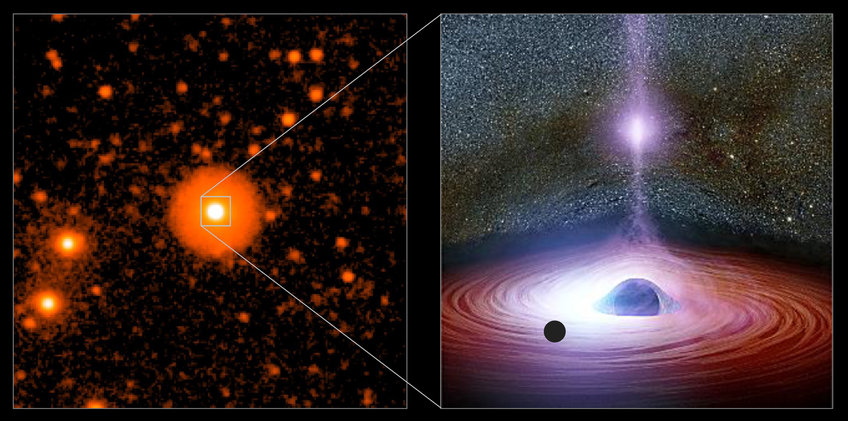Large-scale observational campaign provides new insights into an assumed black hole binary at the centre of the active galaxy OJ 287
A long-term study with data from four telescopes, ranging from radio to high energy frequencies, has penetrated to the core of the much-discussed active galaxy OJ 287, revealing further details about its interior. The results of the international team, led by Stefanie Komossa of the Max Planck Institute for Radio Astronomy, strengthen the evidence for a binary black hole system and place the primary black hole back on the scale.

Blazars are a special class of active galaxies characterised by high activity and extreme luminosity. The driving engines of these galaxies are black holes hidden inside their cores, millions to billions of times heavier than our Sun. Through the course of the history of the universe, these engines were fueled especially when galaxies collided. The subsequent merger of the galaxies created supermassive binary black holes. The study of such black-hole pairs reveals a lot about the evolution of galaxies and the growth of black holes.
Black hole on the scale
OJ 287 is one of the best candidates to host a compact supermassive binary black hole. One indication of this is the exceptional bursts of radiation produced by processes at the centre of the galaxy, which repeat every 11 to 12 years. Strictly speaking, each outburst consists of two peaks separated by roughly one year. These repeating outbursts are so remarkable that several different binary models have been proposed and discussed in the literature to explain them. The team led by Stefanie Komossa at the Max Planck Institute for Radio Astronomy has now revised the previously favoured model by carrying out an unprecedented and systematic observational campaign. In the process, the researchers have also directly determined the mass of the primary black hole for the first time. At 100 million solar masses, it is probably about a hundred times smaller than previously thought. The new estimate of the black hole mass also seems to explain the entire history of OJ 287’s radiation outbursts, which have now been mapped in great detail.
Unveiling the invisible
The galaxy OJ 287 is too distant for telescopes to resolve the compact nucleus around the suspected black holes. However, since this region dominates the brightness of the whole galaxy, the radiation emerging from the core is both easily detectable on Earth and allows astronomers to reconstruct, with some limitations, the processes hidden inside the bright core. To do this, it helps to know the underlying processes. Matter from a disk surrounding the black hole that drifts inward loses gravitational energy in the form of optical and ultraviolet radiation. A jet launched from the surroundings of the central engine accelerates particles outwards. This often highly relativistic stream of matter emits intense radiation ranging from the radio to the X-rays and gamma-rays.

"OJ 287 is an excellent laboratory for studying the physical processes that reign in one of the most extreme astrophysical environments: disks and jets of matter in the immediate vicinity of one or two supermassive black holes”, says Stefanie Komossa from the Max Planck Institute for Radio Astronomy, the leading author of the two studies presented here. “Therefore, we initiated the project Momo („Multiwavelength Observations and Modelling of OJ 287“). It consists of high-cadence observations of OJ 287 at more than 14 frequencies from the radio to the high energy regime lasting for years, plus dedicated follow-ups at multiple ground- and space-based facilities when the blazar is found at exceptional states.”
The outbursts of OJ 287 can be explained by the model of a binary black hole system, in particular by the motion of the second, lower-mass black hole orbiting the primary one. On its inclined orbit, it disturbs either the jet or the disk of matter, thus causing OJ 287's periodic bursts. Measurements with the 100-metre Effelsberg radio telescope attribute the most recent burst directly to the jet. It is like looking into a glaring spotlight that outshines everything behind it.
Strong evidence for two supermassive black holes in the core
The state-of-the-art model describing the processes in the centre of OJ 287 assumed a primary black hole ten billion times heavier than the Sun. According to this model, the next outburst would have been due in October 2022. The actual data did not confirm this prediction. Instead, thanks to the dense coverage of the Momo campaign, the astronomers discovered this outburst much earlier, between 2016 and 2017. The previously favoured model was therefore falsified. The researchers then reassessed the mass of the primary black hole. It turns out to be a hundred times lighter than previously thought. As a result, the orbit of the secondary black hole around the primary black hole should wobble much less. This behaviour has direct implications for the predicted outbursts, which are now consistent with both historical and recent measurements. “This result is very important, as the mass is a key parameter in the models that study the evolution of this binary system: How far are the black holes separated, how quickly will they merge, how strong is their gravitational wave signal?” says Dirk Grupe of the Northern Kentucky University (USA), a co-author of both studies.
Gravitational waves and a photograph?
The Momo results make the authors optimistic that future space-based observatories will be able to detect gravitational waves from this or similar binary systems. It may even be possible to spatially resolve the two black holes in OJ 287 with a large network of radio telescopes, such as the Event Horizon Telescope known from the media or the Square Kilometre Array still under construction. This would be the first direct detection of a close system of two supermassive black holes in the centre of a galaxy.
